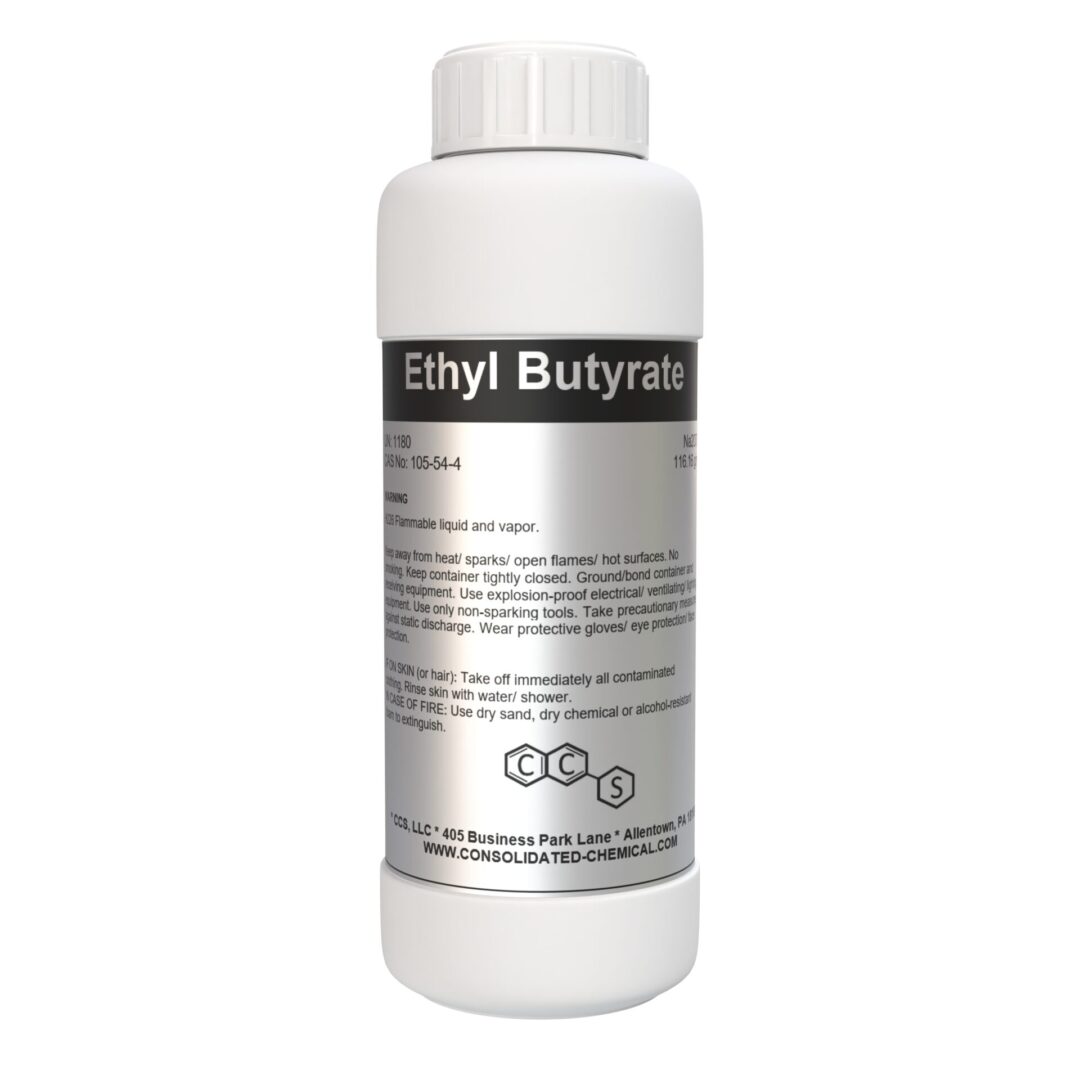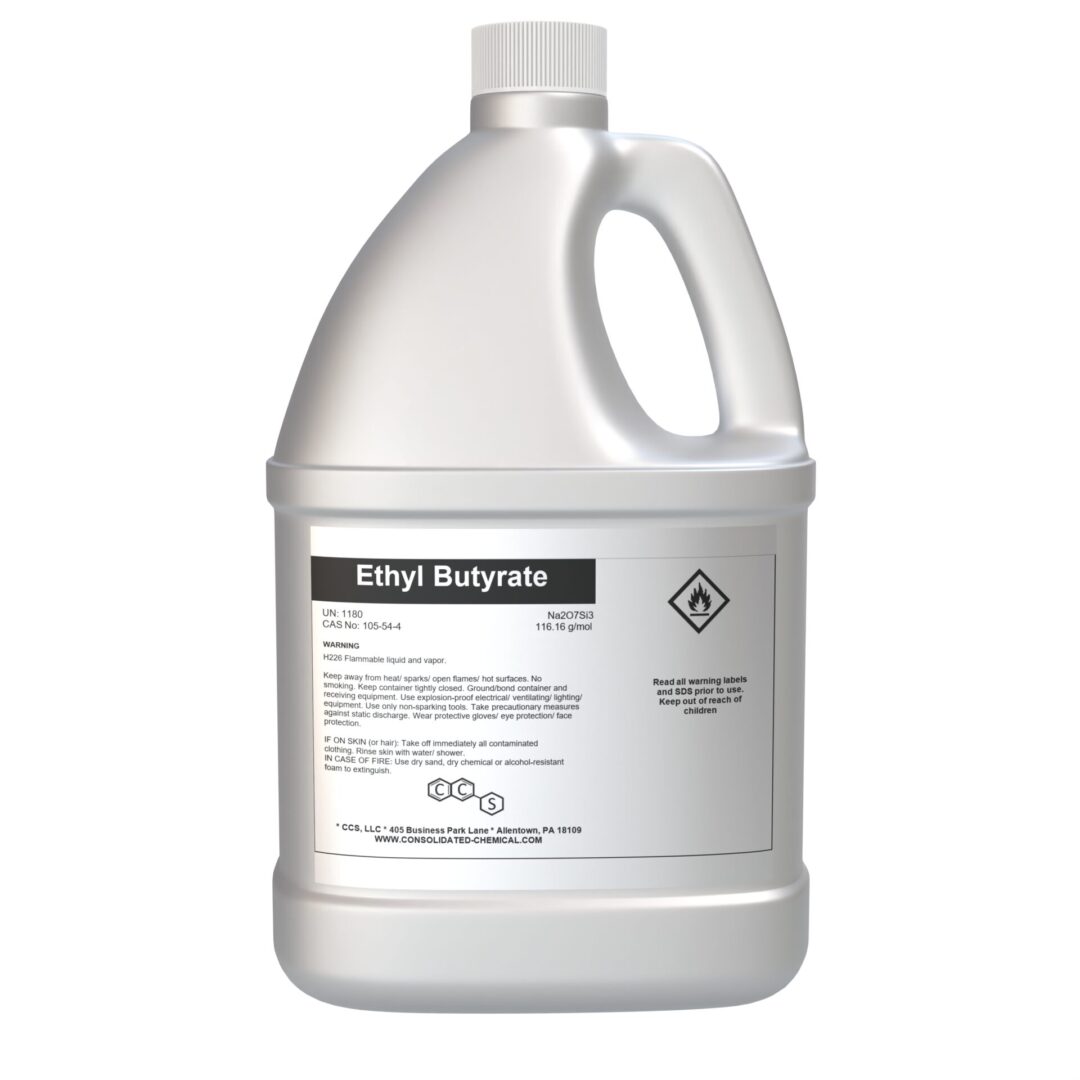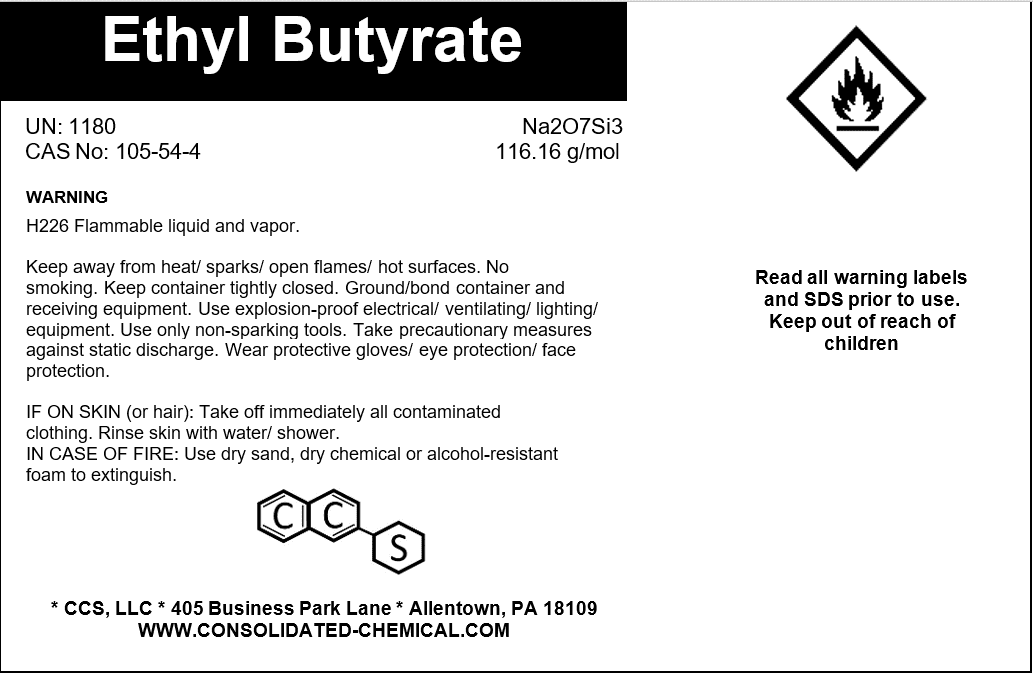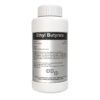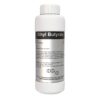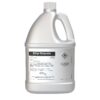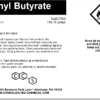Ethyl Butyrate – Food Grade/Fragrance Grade
$19.99 – $59.99
Chemical Identity
- Chemical Name: Ethyl Butyrate (Ethyl Butanoate)
- CAS Number: 105-54-4
- Chemical Formula: C₆H₁₂O₂
- Molecular Weight: 116.16 g/mol
- Structure: CH₃-CH₂-CH₂-COO-CH₂-CH₃ (an ester of ethanol and butyric acid)
Physical Properties
- Appearance: Clear, colorless liquid
- Odor: Sweet, fruity, resembling pineapple or tropical fruits
- Boiling Point: ~120°C (~248°F)
- Melting Point: -93°C (-135°F)
- Flash Point: ~22°C (~72°F), Closed Cup
- Density: 0.879 g/cm³ at 20°C
- Refractive Index: 1.393 at 20°C
- Solubility in Water: Slightly soluble (~1.7 g/L at 20°C)
- Miscibility: Miscible with alcohols, ethers, and most organic solvents
Chemical Properties
- Purity: ≥ 99% (typical for commercial or industrial grade)
- Functional Group: Ester
- Vapor Pressure: 6.1 kPa at 20°C
- Auto-ignition Temperature: ~450°C (~842°F)
- Partition Coefficient (log P): ~1.85 (octanol/water)
Description
Ethyl butyrate (also known as Ethyl butanoate) is a simple, naturally occurring ester with a sweet, fruity aroma. It is widely used across several industries, including food and beverages, fragrances, and industrial manufacturing.
Applications of Ethyl Butyrate
Food and Beverage Industry
- Soft Drinks: Enhances citrus-based flavors like orange, pineapple, and mango.
- Candies: Adds a sweet and fruity flavor to hard and soft candies.
- Baked Goods: Used in cakes, pastries, and cookies for its fruity essence.
- Ice Creams and Desserts: Enhances the flavor profile of tropical-themed products.
- Alcoholic Beverages: Provides a fruity note to cocktails, liqueurs, and craft beers.
Fragrance Industry
- Perfumes and Colognes: Used in floral, fruity, and tropical-themed scents.
- Personal Care Products: Found in shampoos, lotions, and body washes for a refreshing aroma.
- Air Fresheners: Commonly used in home and car fresheners for a clean, fruity scent.
Industrial Applications
- Solvent: Used in coatings, adhesives, and paints due to its ability to dissolve organic compounds effectively.
- Plasticizer: Incorporated in plastics to improve flexibility and durability.
- Resins and Polymers: Aids in the formulation of certain synthetic materials.
Natural Product Enhancement
- Fruit Ripening and Preservation: Used to mimic natural fruit aromas in artificial ripening processes.
- Artificial Flavors: Enhances the natural taste of processed fruits, particularly in jams and canned goods.
Pharmaceutical Industry
- Used as a flavor masking agent in medicines and supplements to improve palatability, especially in chewables and syrups.
- Employed as an excipent in formulations for drug delivery systems.
Agriculture
- Used in insect attractants for monitoring and controlling pest populations.
- Applied in the formulation of biopesticides.
Cosmetics
- Incorporated in lip balms, flavored glosses, and beauty products for its sweet and appealing aroma.
Research and Development
- Extensively used in chemical research for studying esterification reactions and solvent applications.
Storage Guidelines
- Temperature:
- Store in a cool, dry place, ideally between 15°C and 25°C (59°F to 77°F). Avoid exposure to high temperatures or direct sunlight.
- Container:
- Keep in tightly sealed, corrosion-resistant containers (such as HDPE, stainless steel, or glass) to prevent leaks and contamination.
- Ensure containers are labeled correctly to avoid misuse.
- Ventilation:
- Store in a well-ventilated area to minimize the accumulation of vapors, which can be flammable.
- Segregation:
- Keep away from incompatible substances like strong acids, bases, oxidizing agents, and sources of ignition (e.g., flames, sparks, static electricity).
- Spill Containment:
- Use secondary containment (such as a spill tray) to manage accidental leaks or spills.
Handling Guidelines
- Personal Protective Equipment (PPE):
- Wear appropriate PPE, including:
- Chemical-resistant gloves (e.g., nitrile or neoprene)
- Safety goggles or face shield
- Long-sleeved lab coat or protective clothing
- Respiratory protection if handling in poorly ventilated areas
- Wear appropriate PPE, including:
- Work Area:
- Handle in a fume hood or a well-ventilated space to prevent vapor accumulation.
- Avoid inhalation, skin contact, and eye contact.
- Preventive Measures:
- Ground and bond containers when transferring Ethyl butyrate to prevent static discharge.
- Use tools and equipment rated for use with flammable substances.
- First Aid Measures:
- Inhalation: Move to fresh air immediately. Seek medical attention if symptoms persist.
- Skin Contact: Wash thoroughly with soap and water. Remove contaminated clothing.
- Eye Contact: Rinse eyes cautiously with water for several minutes. Seek medical help if irritation persists.
- Ingestion: Do not induce vomiting. Rinse mouth with water and seek medical attention.
Additional information
| Size | 100mL (3.3 Fl Oz), 250mL (8 Fl Oz), 500mL (16 Fl Oz), 1000mL (32 Fl Oz) |
|---|
Related products
-
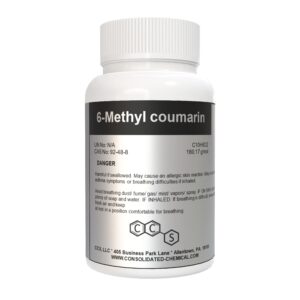
6-Methyl Coumarin | High-Purity Aroma & Industrial Compound
$12.99 – $19.99 Select options This product has multiple variants. The options may be chosen on the product page -

Methyl Isoeugenol – High-Quality Aroma and Flavor Ingredient – 30mL
$12.00 Add to cart -

Cinnamic Acid – High Purity | Premium Quality
$14.99 – $48.00 Select options This product has multiple variants. The options may be chosen on the product page -
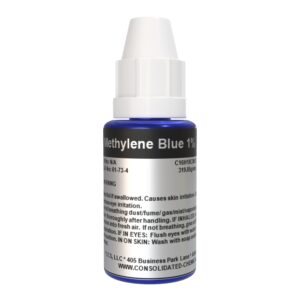
Methylene Blue 1% Aqueous Stain/dye Solution
$12.00 Select options This product has multiple variants. The options may be chosen on the product page
SKU: N/A
Categories: Flavoring Agent, Food Additive, Fragrance Chemical, Fragrances & Aromas (15), Herbicide, Industrial Chemical, Pesticide, Solvents (3)
Tags: 105-54-4, Aroma Chemical for Industrial Use, Best Price Ethyl Butyrate Bulk, Bulk Ethyl Butyrate Supplier, buy ethyl butyrate, Buy Ethyl Butyrate in Europe, Buy Ethyl Butyrate Online, CAS 105-54-4, Ester for Flavors and Fragrances, Ethyl Butanoate, Ethyl Butyrate, ethyl butyrate 99.9%, ethyl butyrate 99%, ethyl butyrate advanced manufacturing, ethyl butyrate alternative solvent, ethyl butyrate alternative to synthetic chemicals, Ethyl Butyrate Applications in Cosmetics, ethyl butyrate aroma chemical, Ethyl Butyrate as a Solvent for Adhesives, ethyl butyrate best manufacturer, ethyl butyrate best sourcing, ethyl butyrate biodegradability, ethyl butyrate blending agent, ethyl butyrate boiling point, ethyl butyrate breakthrough uses, ethyl butyrate bulk orders, ethyl butyrate bulk pricing, ethyl butyrate bulk supplier, ethyl butyrate CAS 105-54-4, ethyl butyrate certified product, ethyl butyrate chemical, ethyl butyrate chemical properties, ethyl butyrate chemical stability, ethyl butyrate clean label, ethyl butyrate commercial applications, ethyl butyrate competitive analysis, ethyl butyrate competitive pricing, ethyl butyrate cost, ethyl butyrate cost-effective solutions, ethyl butyrate density, ethyl butyrate distributor, Ethyl Butyrate Distributor Near Me, ethyl butyrate DOT regulations, ethyl butyrate eco-friendly, ethyl butyrate emergency response, ethyl butyrate environmental impact, ethyl butyrate EPA regulations, ethyl butyrate ester compound, ethyl butyrate EU regulations, ethyl butyrate experimental research, ethyl butyrate explosion risk, ethyl butyrate FCC grade, ethyl butyrate FDA approved, ethyl butyrate fire safety, ethyl butyrate flammability, ethyl butyrate flash point, ethyl butyrate food additive, ethyl butyrate food flavoring, ethyl butyrate food grade, Ethyl Butyrate Food Grade Wholesale, Ethyl Butyrate for Beverages, ethyl butyrate for emerging markets, ethyl butyrate for sale, Ethyl Butyrate for Sale Online Canada, ethyl butyrate fragrance ingredient, ethyl butyrate fruity aroma, ethyl butyrate GHS classification, ethyl butyrate global distribution, ethyl butyrate global market trends, ethyl butyrate global sourcing, ethyl butyrate green chemistry, ethyl butyrate handling precautions, ethyl butyrate hazard classification, ethyl butyrate health benefits, ethyl butyrate high purity, ethyl butyrate holistic wellness, ethyl butyrate hydrolysis, ethyl butyrate import/export, ethyl butyrate in adhesives, ethyl butyrate in agrochemicals, ethyl butyrate in air fresheners, ethyl butyrate in alcoholic beverages, ethyl butyrate in aromatherapy, ethyl butyrate in baked goods, ethyl butyrate in beverages, ethyl butyrate in candles, ethyl butyrate in candy, ethyl butyrate in carbonated drinks, ethyl butyrate in chemical synthesis, ethyl butyrate in cleaning products, ethyl butyrate in coatings, ethyl butyrate in confectionery, ethyl butyrate in cosmetics, ethyl butyrate in dairy products, ethyl butyrate in deodorants, ethyl butyrate in detergents, ethyl butyrate in dispersants, ethyl butyrate in drug formulations, ethyl butyrate in e-liquids, ethyl butyrate in emulsifiers, ethyl butyrate in essential oils, ethyl butyrate in excipients, ethyl butyrate in fertilizers, ethyl butyrate in flavor industry, Ethyl Butyrate in Food and Beverage Industry, ethyl butyrate in fruit flavors, ethyl butyrate in fruit juice, ethyl butyrate in functional foods, ethyl butyrate in herbicides, ethyl butyrate in household cleaners, ethyl butyrate in ice cream, ethyl butyrate in incense, ethyl butyrate in lotions, ethyl butyrate in medicine, ethyl butyrate in paints, ethyl butyrate in perfumery, ethyl butyrate in personal care, ethyl butyrate in pesticides, ethyl butyrate in pharmaceuticals, ethyl butyrate in plasticizers, ethyl butyrate in polymers, ethyl butyrate in reed diffusers, ethyl butyrate in resins, ethyl butyrate in rubber industry, ethyl butyrate in shampoos, ethyl butyrate in skincare, ethyl butyrate in soaps, ethyl butyrate in surfactants, ethyl butyrate in syrups, ethyl butyrate in textiles, ethyl butyrate industrial grade, ethyl butyrate industrial solvent, ethyl butyrate industry demand, ethyl butyrate industry partnerships, ethyl butyrate industry standards, ethyl butyrate intermediate compound, ethyl butyrate international trade, ethyl butyrate laboratory applications, ethyl butyrate laboratory grade, ethyl butyrate long-lasting fragrance, ethyl butyrate low VOC, ethyl butyrate low-toxicity, ethyl butyrate manufacturer, ethyl butyrate market growth, ethyl butyrate market trends, ethyl butyrate melting point, ethyl butyrate molecular formula, ethyl butyrate molecular weight, ethyl butyrate MSDS, ethyl butyrate natural extract, ethyl butyrate natural flavor, ethyl butyrate new product development, ethyl butyrate next-generation applications, ethyl butyrate niche applications, ethyl butyrate non-polar solvent, ethyl butyrate online purchase, ethyl butyrate organic compound, ethyl butyrate organic solvent, ethyl butyrate organic synthesis, ethyl butyrate oxidation, ethyl butyrate perfumery raw material, ethyl butyrate personal protective equipment, ethyl butyrate pharmaceutical grade, ethyl butyrate physical properties, ethyl butyrate pineapple aroma, ethyl butyrate premium quality, ethyl butyrate price, ethyl butyrate product innovation, ethyl butyrate REACH certification, ethyl butyrate reagent grade, ethyl butyrate refractive index, ethyl butyrate regulatory compliance, ethyl butyrate renewable, ethyl butyrate research and development, ethyl butyrate research chemical, ethyl butyrate safe disposal, ethyl butyrate safety data sheet, ethyl butyrate scent profile, ethyl butyrate scientific studies, ethyl butyrate SDS, ethyl butyrate shelf life, Ethyl Butyrate Shipping Worldwide, ethyl butyrate signature note, ethyl butyrate solubility, Ethyl Butyrate Solvent, ethyl butyrate solvent properties, ethyl butyrate specialty formulations, ethyl butyrate stability, ethyl butyrate storage conditions, ethyl butyrate supplier, Ethyl Butyrate Supplier USA, ethyl butyrate supply chain, ethyl butyrate sustainable ingredient, ethyl butyrate sweet scent, ethyl butyrate synthetic flavor, ethyl butyrate technical grade, ethyl butyrate top suppliers, ethyl butyrate toxicity, ethyl butyrate transport regulations, ethyl butyrate US regulations, ethyl butyrate USP grade, ethyl butyrate vaping flavor, ethyl butyrate vapor pressure, ethyl butyrate verified supplier, ethyl butyrate versatile ingredient, ethyl butyrate volatility, ethyl butyrate wholesale, Flavor Additive for Candies, Flavor and Fragrance Chemical, Food Grade Flavoring Ester, Fragrance Ingredient Ethyl Butyrate, Fruity Flavor Additive, high-purity ethyl butyrate, High-Purity Ethyl Butyrate for Sale, Natural Food Flavoring Agent, Organic Compound for Beverages, Perfumery Ingredients Supplier, Pineapple Flavor Compound, Solvent for Coatings and Adhesives, Sweet and Fruity Aroma Ester, Sweet Fruity Aroma Chemicals Supplier, Tropical Fruit Aroma Compound, Uses of Ethyl Butyrate in Fragrances, Where to Buy Ethyl Butyrate for Flavoring



